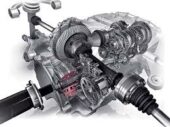
ASR system what is it in a car
Content
In the list of technical characteristics of modern cars, there are a lot of incomprehensible abbreviations, the mention of which for some reason is considered a good marketing ploy. One brand trumps the ASR system, the other mentions ETS, the third - DSA. What, in fact, do they mean and what influence do they have on the behavior of the car on the road?
ASR stands for Electronic Traction Control, often also referred to as Tcs or Traction Control System. The origin of Asr is always in English: the three letters actually summarize the formulations "Anti-slip regulation" or "Anti-slip regulation".
Decipher Abbreviations
What does the owner of the brand want to say, indicating that his cars are equipped with the ASR system? If you decipher this abbreviation, you get the Automatic Slip Regulation, and in translation - the automatic traction control system. And this is one of the most common design solutions, without which modern cars are not built at all.

However, each manufacturer wants to show that his car is the coolest and most special, so he comes up with his own abbreviation for his traction control system.
- BMW is ASC or DTS, and the Bavarian automakers have two different systems.
- Toyota - A-TRAC and TRC.
- Chevrolet & Opel - DSA.
- Mercedes - ETS.
- Volvo - STS.
- Range Rover - ETC.
It hardly makes sense to continue the list of designations for something that has the same algorithm of operation, but differs only in details - that is, in the way of its implementation. Therefore, let's try to understand what the principle of operation of the anti-slip system is based on.
How ASR works
Slip is an increase in the number of revolutions of one of the driving wheels due to the lack of adhesion of the tire to the road. To slow the wheel down, a brake connection is required, so the ASR always works in tandem with ABS, a device that prevents the wheels from locking when braking. Structurally, this is implemented by placing the ASR solenoid valves inside the ABS units.
However, placement in the same enclosure does not mean that these systems duplicate each other. ASR has other tasks.
- Equalization of the angular speeds of both driving wheels by locking the differential.
- Torque adjustment. The effect of restoring traction after a gas release is known to most motorists. ASR does the same, but in automatic mode.
What ASR reacts to
To fulfill its duties, the traction control system is equipped with a set of sensors that take into account the technical parameters and behavior of the car.
- Determine the difference in the angular speeds of rotation of the driving wheels.
- Recognize the yaw rate of the vehicle.
- They react to deceleration when the angular speed of rotation of the driving wheels increases.
- Take into account the speed of movement.
Basic modes of ASR operation
Wheel braking occurs when the vehicle is moving at a speed of less than 60 km / h. There are two types of system responses.
- At the moment when one of the driving wheels starts to slip - its angular rotation speed increases, the solenoid valve is triggered, blocking the differential. Braking occurs due to the difference in frictional force under the wheels.
- If the linear displacement sensors do not register the movement or note its deceleration, and the drive wheels increase the rotation speed, then a command is given to activate the brake system. The wheels are slowed down by physical holding, due to the frictional force of the brake pads.
If the vehicle speed is more than 60 km / h, then the engine torque is regulated. In this case, the readings of all sensors are taken into account, including those determining the difference in angular velocities of various points of the body. For example, if the rear bumper starts to "run around" the front one. This allows you to reduce the yaw rate of the vehicle and skidding, and the reaction to this behavior of the vehicle is many times faster than with manual control. ASR works by short-term engine braking. After the return of all parameters of movement to an equilibrium state, it gradually gains momentum.
When was the ASR system born?
They started talking about ASR in the middle eighties , but until a few years ago it was a system that was installed exclusively on more expensive cars or sports cars.
Today, however, car manufacturers are required to install ASR on all new vehicles, both as a standard feature and as an option.
In addition, since 2008, ASR testing has also started on motorcycles to guarantee a much higher level of safety for them as well.
What is an automotive ASR for?
The ASR device reduces the slippage of the drive wheels by changing the power delivered by the engine: the system works through a converter and a sonic wheel connected to the wheels themselves; when the inductive proximity sensor detects an insufficient number of passes, it sends a signal to the electronic control unit that controls the ASR. In other words, when the wheels sense a loss of traction, the ASR intervenes by reducing engine power, shifting it to the wheel that from this point of view appears to be "weaker". The main effect obtained is to increase the acceleration of the wheel to restore the same speed with other wheels.
ASR can be controlled manually by the driver himself, who can disable and activate it as needed, but on more modern vehicles this function is controlled automatically by special integrated systems.
Advantages the ASR device certainly has. In particular, it provides confident overcoming off-road in critical conditions, allows you to quickly compensate for the loss of traction with the wheel and is useful during sports competitions. However, it also has disadvantages. with driving on loose off-road and where there is a need for drifting while driving.
When to disable ASR?
As mentioned in the previous paragraph, the function traction control can be controlled by the driver independently, depending on the traffic conditions. While this is useful when driving on a road surface that has become slippery due to certain weather conditions, its presence can create problems when starting off. In fact, it is useful to deactivate the traction control system when starting off, and then activate it when the car is already moving.
Like other built-in functions, the tool vehicle traction control also contributes to raising driving safety standards. Safety, which concerns not only those who are with us in the car, but also those who meet us on the way.
Video about stabilizing systems ASR, ESP
Questions and answers:
What are ESP and ASR? ESP is an electronic stability control system that prevents the car from skidding when cornering at speed. ASR is part of the ESP system (during acceleration, the system prevents the drive wheels from spinning).
What is the ASR button for? Since this system prevents the drive wheels from slipping, naturally, it will prevent the driver from performing a controlled drift drift. Disabling this system makes the task easier.


